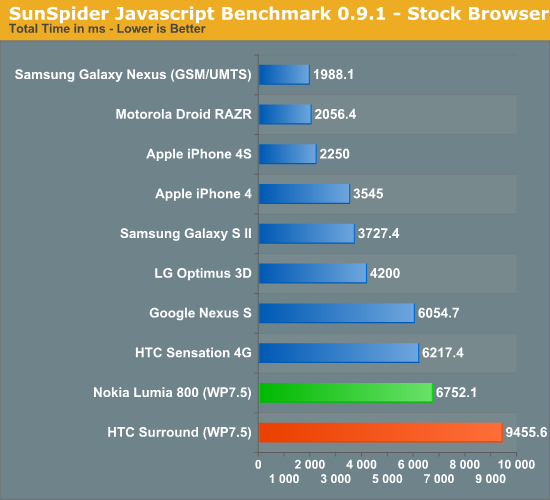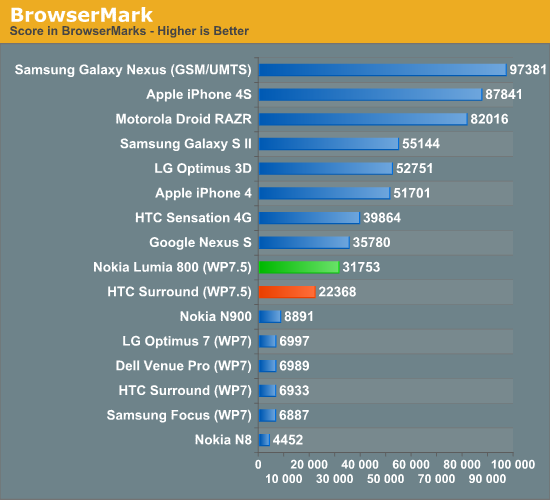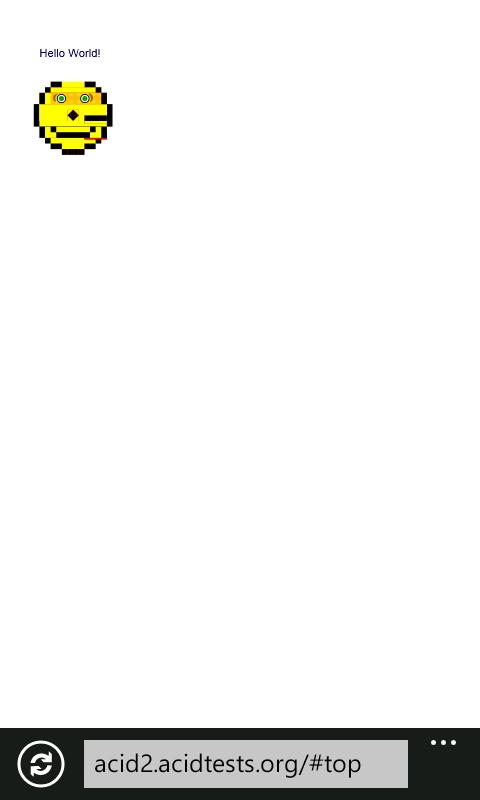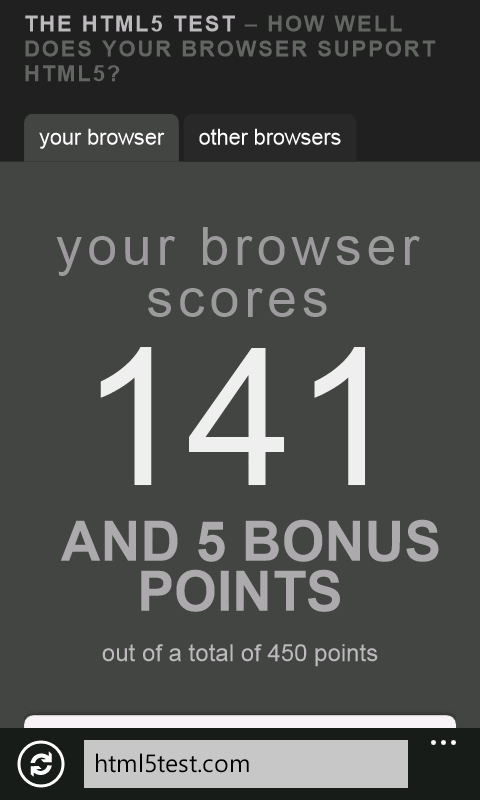Nokia Lumia 800 Review - Nokia's Brave New Foray into WP7
by Brian Klug on January 4, 2012 7:00 AM EST- Posted in
- Smartphones
- Nokia
- windows phone 7
- Mobile
- WP7
- Lumia
- Lumia 800
Unfortunately, the majority of benchmarks that usually grace our smartphone reviews don’t yet have WP7 ports or analogs, but there are a still a number of comparisons we can make. To start, the browser-based performance metrics give a good picture within the Windows Phone ecosystem, and likewise with WPbench, created by one of our own readers and on the marketplace.
There’s been a lot written about performance on WP7 already - namely that comparative analysis isn’t as big of a deal as it is on other smartphone platforms, but of course this is more the result of two things. First, Microsoft’s careful curation of their new smartphone platform with hardware requirements; second, availability of native and managed code execution environments. For the most part, you can pick up any WP7 device and have very good expectation of UI smoothness, but that’s not to say there aren’t differences, especially as the platform moves from one generation of Snapdragon SoC to the next, and now possibly even a move to ST-E. Benchmarking WP7 (and by analog, Windows 8) will become a big deal very soon, however, and numerous SoC vendors and big names in the PC benchmarking scene are looking to port to these platforms.
This current refresh of WP7 devices continues to be based around exclusively Qualcomm SoCs, and the Lumias are no exception. Both the 710 and 800 are based around Qualcomm’s MSM8255 single core S2 Snapdragon at 1.4 GHz with Adreno 205 graphics at the core and dual channel LPDDR2 memory interfaces. This is a 45nm part we’ve seen and explored numerous times before, and as a refresher includes the HSPA+ 14.4 baseband onboard.
Anyhow, onward to the numbers. First is sunspider, which we’ve been using for a long while and recently changed from 0.9 to 0.9.1 with. As a result, I’ve had to re-run devices since the numbers aren’t directly comparable. WP7.5 brings a much improved javascript engine which gives it a big boost in scores. I’ve managed to hang onto the HTC Surround (1.0 GHz QSD8250) and Anand has the Focus (also 1.0 GHz QSD8250), which we’ve included as well.

Browsermark hasn’t changed or forced us to re-run things, so we have comparison numbers that show how much difference there is in the browser department in WP7.5.

In the synthetics, WP7.5’s new JavaScript engine (Chakra) with JIT brings perf almost up to modern levels and is a step in the right direction, but it’s still behind iOS and Android. Moving to a higher clocked single core probably does make sense for Windows Phone, especially if IE is single threaded at this point.
For system benchmarking on WP7.5 we have WP Bench, which was created by one of our own readers. The benchmark reports a total score in addition to three sub-scores for CPU, memory, and GPU. My only point of comparison, again, is the HTC Surround.
| WPBench Comparison | ||
| HTC Surround (1.0 GHz QSD8250) | Nokia Lumia 800 (1.4 GHz MSM8255) | |
| Total Score | 59.85 | 91.14 |
| Result Screenshot |
|
|
Browser Performance and Changes
I’ve made a big deal about browsing performance because, for me at least, the stock browser is the one place where performance really must be flawless. OEMs are starting to wake up to the fact that browsing performance makes a huge impact on the overall subjective weighting of a platform’s smoothness, which in turn results in a lot of scrutiny. I’d agree with this assertion as well and toss in a few other things that must be flawless for a platform to feel speedy.
When WP7.5 first started surfacing we took a look at its revamped IE9-based browser which uses Trident 5.0 as opposed to NoDo’s Trident 3.1. Unsurprisingly everything we saw in the emulator applies to the real-world experience with WP7.5 on live devices. Actually things are even a bit better than they were when we played around in the emulator.


The Windows Phone team has made clear several times that they aren’t going to build the browser to any tests but instead real-world page rendering accuracy. That said it’s still worthwhile to take a look at the synthetics. Acid 3 now completes and nearly passes (the boxes in top right subtract some points) where it previously scored below 95. Similarly Acid 2 now is almost flawless. Finally, the HTML5test score increases from 130 to 141 on the Lumia 800 and newer WP7.5 builds, which is a slight but still important difference.

Moving away from Trident 3.1 to 5.0 has made a huge difference on faithful page rendering and eliminated nearly all of the annoying edge cases I saw with previous WP7 smartphones. A number of pages I visit daily back when we did those reviews would render but with a few notable errata, these are now gone completely.
In addition, scrolling performance remains just as speedy as it was before (essentially buttery smooth) as the rendering architecture remains largely the same. We now have all three platforms (WP7.5, iOS, and Android 3.x/4.x) rendering the browser page into a texture that can be translated, clipped, and zoomed with GPU operations. It’s clear that this is the right way to do things to keep the browser UI speedy.
The changes to WP7.5’s browser make (for me at least) the single most notable improvement over NoDo and previous iterations. It’s a huge step forwards in rendering, compliance, and UI, and having that browser experience be as close to perfect as possible is tremendously important.












120 Comments
View All Comments
Iketh - Wednesday, January 4, 2012 - link
You can't watch youtube videos without the app on WP. If you try, the website instructs you to download the youtube app first. You can browse youtube all you want, just can't play the videos. The way the site words this almost makes it sound like it's youtube's fault, but I wouldn't know.melgross - Wednesday, January 4, 2012 - link
So, this is a fairly mediocre phone as far as performance goes, but the reviewer really wants to believe it to be better than it is.It's pretty obvious that WP7+ needs a dual core SoC, with a much better GPU. When that happens, we'll see a phone that can properly compare to the other top phones on other OS's, such as Android and iOS. Until then, no excuses can fix the slow nature of this model. If this were a cheaper, lower end model, it might be worthwhile, but for the flagship model, it's simply not worth it.
And then, AMOLED isn't really ready for prime time. Despite the propaganda from the manufacturers who use them, I've not yet seen a review of an AMOLED device that was more than about half as bright as a good LCD model, and often no better than a third as bright. This one seems poor. To say that it seems brighter than it can possibly be, is nonsense.
I hope that we will see much better phones than this one during the year, and soon. If not, it will be another reason why WP7 will struggle.
Brian Klug - Wednesday, January 4, 2012 - link
I'd agree with that assertion - WP7 does need to make the move to dual core, (and will make the move to dual core) if nothing else to get all the other features that come with it. I touched on this a little, but better encoders, better decoders, and on the QCT side better baseband all come on the high-end before eventually showing up on the midrange.The other curious thing is that AMOLED can actually go way brighter (with some of Supercurio's hacks, you can drive the SGS2 SAMOLED Plus display up past 500 nits) but you end up just burning through battery. Obviously there's still some balancing being done by OEMs to keep battery from being totally depleted.
-Brian
melgross - Wednesday, January 4, 2012 - link
There are several very good reasons why AMOLEDs aren't bright. LED's of all kinds, but especially OLED'S, are very constrained by temperature. The higher they are driven, the hotter they get. The hotter they get, the shorter the life. Driving an AMOLED screen to the brightness of the 4S, for example, would bring the lifetime down to less than a quarter of what it is now.In addition, this isn't a linear relationship. More voltage results in less than a 1:1 relationship in brightness, and an even worse relationship when looking at current draw. There's a good reason why UI's designed for AMOLED's use a great deal of black with thin lettering. On average, right now, even the best AMOLEDs use more current than do most LCDs with high efficiency LED backlighting. I find it amusing when I read that AMOLEDs use less energy, when they use more.
I have a lot of LED's here, up to 200 watts (for a single LED). I've yet to find one that lives up to its promise, though they're getting better. I would give AMOLED's at least another two years, and with IGZO displays coming out, possibly another four years until they equal the efficiency.
Color quality, which is poor, is another question altogether.
french toast - Thursday, January 5, 2012 - link
AMOLEDs typically dont come half as bright as the brightest lcds, hell the nokia 701 gets over 1000nits brightness!! so thats 5 times brighter than this model.However brightness tests like this rarely carry through to real life,especially when talking about AMOLEDS, they have the best contrast ratio as well as saturated colours which make the screen pop, you never read a review about an AMOLED phone and get complaints about it being dull..quite the contrary the AMOLED always seems to be brighter..
If brian hadnt ran that test, he wouldnt have mentioned that the screen seems dull.
Some of the appeal of AMOLEDS is that over saturated colour profile, which seems to be a marmite issue, half the people prefer IPS LCD and half swear by a decent RGB AMOLED.
AMOLEDS have many advantages over LCD though, they are thinner, much much better contrast, far far superior response time, more eye popping colours and better power levels when watching dark seens like movies...The sunlight issue which was the worse complaint has disapeared.
One of the biggest complaints about AMOLED compared to a high quality LCD is color accuracy..BUT although this is a bug for some,
most people PREFER the saturated colors, indeed when i read reviews on you tube of people comparing the most accurate hd phone display yet..the IH-IPS display on the LG Nitro the reviewers said they much prefered the nexus display, and that somehow it gave the impression of being BRIGHTER..despite what these tests say.
Spivonious - Wednesday, January 4, 2012 - link
Slow nature of this model? I have one of the launch WP7 phones (LG Quantum), and experience no slowness. The fact is that MS has optimized the OS to perform on a single-core CPU. The phone OEMs are free to add an improved GPU, but there's no need for it. Javascript benchmarks are meaningless to me. Who browses the web for any amount of time on a 4" screen?melgross - Wednesday, January 4, 2012 - link
Just read the tests. It's all there. Sometimes something doesn't feel as slow, or as fast as it is, but the numbers don't lie.465thGTG - Wednesday, January 4, 2012 - link
I'll take real world feel over benchmark numbers any day. My Titan feels faster and more fluid than my Galaxy S II. What else is there to say?doubledeej - Thursday, January 5, 2012 - link
If someone spent all day every day running Javascript, I might agree with you. But so little of the time spent using the phone is spent doing that. Everything else about the phone feels much faster than ANY Android model, regardless of CPU speed or number of cores. Having everything be GPU accelerated makes a world of difference in how fast it feels.You just never wait for anything other than your data connection on these phones.
doobydoo - Saturday, January 7, 2012 - link
I've never tried the Titan, but your reasoning is exactly why the iPhone 4S feels faster than the Galaxy S2 too - the GPU hardware acceleration.That and the fact it has the fastest CPU/GPU combination of any phone ever made.